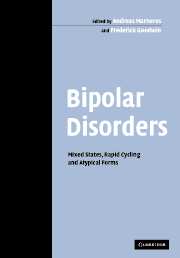Book contents
- Frontmatter
- Contents
- List of contributors
- Preface
- 1 Bipolar disorders beyond major depression and euphoric mania
- 2 Emerging concepts of mixed states: a longitudinal perspective
- 3 Rapid-cycling bipolar disorder
- 4 Bipolar I and bipolar II: a dichotomy?
- 5 Recurrent brief depression as an indicator of severe mood disorders
- 6 Atypical depression and its relation to bipolar spectrum
- 7 Agitated depression: spontaneous and induced
- 8 Schizoaffective mixed states
- 9 Acute and transient psychotic disorder: an atypical bipolar disorder?
- 10 Bipolar disorder in children and adolescents
- 11 Atypical features of bipolarity in old age
- 12 Comorbidity in mixed states and rapid-cycling forms of bipolar disorders
- 13 Challenges in the genetics of bipolar disorder
- 14 Biological aspects of rapid-cycling and mixed states
- 15 The treatment of bipolar mixed states
- 16 The use of atypical antipsychotic agents in the treatment of diagnostic subgroups of bipolar disorder: mixed and pure states, psychotic and non-psychotic
- 17 Investigational strategies: treatment of rapid cycling, mixed episodes, and atypical bipolar mood disorder
- Index
- References
12 - Comorbidity in mixed states and rapid-cycling forms of bipolar disorders
Published online by Cambridge University Press: 10 August 2009
- Frontmatter
- Contents
- List of contributors
- Preface
- 1 Bipolar disorders beyond major depression and euphoric mania
- 2 Emerging concepts of mixed states: a longitudinal perspective
- 3 Rapid-cycling bipolar disorder
- 4 Bipolar I and bipolar II: a dichotomy?
- 5 Recurrent brief depression as an indicator of severe mood disorders
- 6 Atypical depression and its relation to bipolar spectrum
- 7 Agitated depression: spontaneous and induced
- 8 Schizoaffective mixed states
- 9 Acute and transient psychotic disorder: an atypical bipolar disorder?
- 10 Bipolar disorder in children and adolescents
- 11 Atypical features of bipolarity in old age
- 12 Comorbidity in mixed states and rapid-cycling forms of bipolar disorders
- 13 Challenges in the genetics of bipolar disorder
- 14 Biological aspects of rapid-cycling and mixed states
- 15 The treatment of bipolar mixed states
- 16 The use of atypical antipsychotic agents in the treatment of diagnostic subgroups of bipolar disorder: mixed and pure states, psychotic and non-psychotic
- 17 Investigational strategies: treatment of rapid cycling, mixed episodes, and atypical bipolar mood disorder
- Index
- References
Summary
Relevance of comorbidity
In recent years, much has been written on the comorbidity of bipolar disorders with other mental illnesses. Several studies have reported distinct patterns showing how bipolar disorders and other mental disorders co-occur (Brieger, 2000; McElroy et al., 2001). Generally, in patients with bipolar disorders, there is an unexpected excess of co-occurring anxiety disorders and substance-abuse disorders. Concerning personality disorders, there is some evidence that patients with bipolar disorders show higher rates than the normal population, but lower rates than patients with unipolar affective disorders (Brieger et al., 2003a). Such results are descriptive. Therefore, one has to examine the relevance of these findings. Some analyses have cast doubt as to whether one can simply assume that the more disorders a patient suffers from, the more impaired he or she is (Strakowski et al., 1992; Brieger et al., 2002a). Nevertheless, in several studies, comorbidity tended to be a complicating factor (Zimmerman and Mattia, 2000; McDermut et al., 2001). In addition to other elements, it may lead to an increase in the length of hospital stay (Wancata et al., 2001).
A useful definition of comorbidity is the “joint occurrence of two or more mental disorders occurring with each other and/or with medical conditions” (Klerman, 1990). Classical psychiatrists, such as Karl Jaspers (1973), postulated that all signs of an illness should be subsumed under a single diagnosis, which usually implies that this “main diagnosis” is meaningful in terms of prognosis and outcome.
Keywords
- Type
- Chapter
- Information
- Bipolar DisordersMixed States, Rapid Cycling and Atypical Forms, pp. 263 - 276Publisher: Cambridge University PressPrint publication year: 2005
References
- 1
- Cited by



